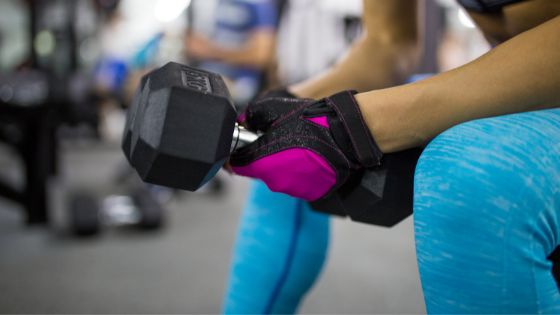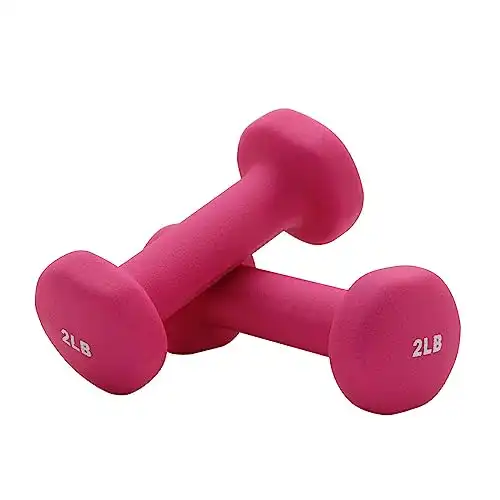Are 3-kg dumbbells suitable for a beginner?

Are 3-kg dumbbells suitable for a beginner? Yes, a pair of 3-kg dumbbells is an excellent place to start for most beginners. With these weights, you'll be able to do various exercises that work for all the major muscle groups.
You can get a full-body workout with just a pair of 3-kg dumbbells, from biceps curls to triceps extensions.
And as you get stronger, you can always increase the weight and challenge yourself further.
So if you're starting, don't be discouraged if the 3-kg weights seem too light. They're just suitable for getting started on your fitness journey!
What are dumbbells, and what do they do?
Dumbbells are a type of free weight that you can use for various strength-training exercises.
Unlike barbells, which you lift with both hands, you lift dumbbells with one hand at a time.
That allows each arm to work independently, which can be beneficial for correcting muscular imbalances.
Dumbbells can be made from various materials, including iron, steel, and rubber.
They come in various sizes and weights, making them suitable for people of all strength levels. In addition to building muscle, you can also use dumbbells for cardiovascular conditioning and weight loss.
By adding dumbbells to your workout routine, you can gain all the benefits of strength training without needing expensive gym equipment.
Different types of dumbbells
There are several different types of dumbbells that you can choose from, depending on your needs.
Standard dumbbells
Standard dumbbells have a uniform weight and size, making them ideal for beginners.
However, they come in various weights, ranging from 1 kg to over 50 kg.
Adjustable dumbbells
Adjustable dumbbells have weight plates that can be added or removed, allowing you to adjust the weight as needed.
These are a good choice for people who want to save space and money by only buying one set of dumbbells.
They can also be adjusted to accommodate different exercises and levels of strength.
Hexagonal dumbbells
Hexagonal dumbbells have a hexagonal shape that prevents them from rolling away when not in use.
That makes them a good choice for people working out at home who don't want to worry about the dumbbells getting damaged or lost.
How to choose the correct weight
When choosing a weight, it's essential to consider your fitness goals and your current strength level.
If you're new to strength training, it's best to start with a lighter weight and gradually increase the amount of weight as you get stronger.
For most people, a pair of 3-kg dumbbells is an excellent place to start.
As you get stronger, you can increase the weight to 5 kg, 10 kg, or even heavier.
Choosing a weight that allows you to complete all the prescribed reps for an exercise is also essential.
If the weight is too heavy, you won't be able to complete all the reps.
And if it's too light, the exercise won't be challenging enough, and you won't see any results.
To find the right weight for you, start with a lighter weight and increase it until you find a weight that allows you to complete all the prescribed reps while still providing a challenge.
What are some benefits of using dumbbells?
There are many benefits to using dumbbells, especially for beginners.
- They are cheap. Dumbbells are inexpensive, and you can purchase them at most sporting goods stores.
- They are easy to store. Dumbbells are also small and easy to store, making them a good choice for people who don't have a lot of space.
- You can target all muscle groups. You can use dumbbells for various strength-training exercises that target all the major muscle groups. You can get a full-body workout with just a pair of 3-kg dumbbells, from biceps curls to triceps extensions.
- They help you to correct muscular imbalances. Dumbbells are also a good choice for people who want to correct muscular imbalances.
By working each arm independently, you can ensure that both sides get equal work.
That training can help prevent injuries and improve your overall strength and coordination.
How to use them
Dumbbells are a great way to add resistance training to your workout routine. They come in various sizes and weights so you can choose the right dumbbells for your fitness level. Here's how to use them:
Start with a lightweight
Choose a weight you can lift 10-15 times without feeling too exhausted.
1-Perform the desired exercise with good form
Keep your back straight and avoid using momentum to swing the dumbbells.
2-As you get stronger, you can increase the weight of the dumbbells
Challenging yourself with heavier weights will help you build muscle and strength.
3-Return them to their place
When you have finished using the dumbbells, please return them to their storage place so they're ready for the next person.
Things to consider before starting with dumbbells
There are a few things you should consider before starting with dumbbells.
- First, it's essential to find the right weight for you. If the dumbbells are too heavy, you'll risk injury. If they're too light, you won't get the full benefit of the exercise.
- Second, make sure you have a good grip on the dumbbells. Your hands should be positioned so that you can maintain a firm grip throughout the entire exercise.
- Third, be aware of your form. That is especially important when doing exercises like bicep curls, where bad execution can lead to injuries.
- Finally, don't be afraid to experiment. There are a ton of different exercises you can do with dumbbells, so don't be scared to try something new.
By following these tips, you'll be able to get the most out of your dumbbell workout.
Now I'm going to leave you with a YouTube video of Caroline Girvan performing a full-body workout with dumbbells that may benefit you.
The ideal repetition range to exercise with dumbbells.
Dumbbells are a staple in any gym, and for a good reason. They're versatile, you can use them for many exercises, and they come in a range of weights.
But how many repetitions should you be doing with dumbbells? It depends on your goals.
- To lose weight. If you're looking to lose weight, aim for above 15 repetitions. That will help you to burn more calories and fat.
- To gain muscle mass. If you want to gain muscle mass, aim for between 6-12 repetitions. That will help you to build more muscle.
- To gain strength. And if you want to gain strength, aim for 1 to 6 repetitions. That will help you to build more strength and power. So whether you're looking to lose weight, gain muscle, or gain strength, there's a repetition range that's ideal for you. Grab some dumbbells and get started today!
Final words
Dumbbells are a great place to start if you're starting with weightlifting. In this article, we've given you tips on how to use them and make the most of your workouts.
Check out our other articles for more information on strength training and getting in shape.
And as always, if you have any questions, don't hesitate to contact us. We're here to help!
DISCLAIMER: buildyourbody.org does not provide medical advice, examination, or diagnosis.
Medically reviewed and approved by Nataniel Josue M D.

